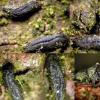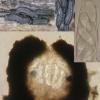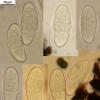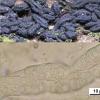
07-01-2026 22:22
 Danny Newman
Danny Newman
Tatraea sp. on indet. hardwood The Swag, Great Sm

10-01-2026 01:18
 Danny Newman
Danny Newman
cf. Neovaginatispora fuckelii on indet. shrub Pre

07-01-2026 10:24
 Danny Newman
Danny Newman
Pezicula sp. on indet. hardwood Appalachian Highl

09-01-2026 17:41
Arnold BüschlenHallo, F. dilatata wird von vielen Bryoparasiten

09-01-2026 10:08
 Blasco Rafael
Blasco Rafael
Hola, en el mismo habitat que la anteriorRetamaDia

08-01-2026 21:22
 Blasco Rafael
Blasco Rafael
Hola, He recogido esta muestra de Orbilia sobre Re

07-01-2026 17:29
 Marc Detollenaere
Marc Detollenaere
Dear Forum,On a barkless Populus I found some smal

10-11-2021 17:33
 Riet van Oosten
Riet van Oosten
Add-on topic http://www.ascofrance.com/forum/7059

07-01-2026 10:05
 Danny Newman
Danny Newman
cf. Chaetospermum on XylariaCosby Campground, Grea
Hysterobrevium smilacis?
Björn Wergen,
11-05-2011 00:50
 Hi,
Hi,Yesterday I checked my Gloniopsis finding again and made some new photos from it. I have compared it with my G. praelonga and I do not think that this is the same species, because the shape of the spores is different from G. praelonga.
After using a key from E. Boehm it seems as if my recolt is H. smilacis...but is it right? I show you the pics and perhaps you can help me ;)
substrate is Salix sp.
many thanks and regards,
Kazuya
----------------------
macro (x40)
Alain GARDIENNET,
11-05-2011 10:30
Re:Hysterobrevium smilacis?
Yes, it is.
I recognize the typical form of ascospores.
It's a very common species. I have a lot of various substrates (perhaps more than 15) for it.
I've never seen praelonga. On Rubus, always I have found smilacis for example.
I think a lot of mycologists named praelonga recolts refering to smilacis.
So I would be very interested to see a true praelonga. I read you have a recolt ?
Best regards,
Alain
I recognize the typical form of ascospores.
It's a very common species. I have a lot of various substrates (perhaps more than 15) for it.
I've never seen praelonga. On Rubus, always I have found smilacis for example.
I think a lot of mycologists named praelonga recolts refering to smilacis.
So I would be very interested to see a true praelonga. I read you have a recolt ?
Best regards,
Alain
Björn Wergen,
11-05-2011 13:01

Re:Hysterobrevium smilacis?
Hi Alain,
thank you for the answer. I had the same thoughts about G. praelonga, after comparing the two species I recognized that my literature about G. praelonga and my own finding have to be redeterminated. My finding "G. praelonga" has spore size 18-22x9-10,5 µm and mostly 3-4 septa. Perhaps is is not G. praelonga and also not H. smilacis, I will show it here:
thank you for the answer. I had the same thoughts about G. praelonga, after comparing the two species I recognized that my literature about G. praelonga and my own finding have to be redeterminated. My finding "G. praelonga" has spore size 18-22x9-10,5 µm and mostly 3-4 septa. Perhaps is is not G. praelonga and also not H. smilacis, I will show it here:
Alain GARDIENNET,
11-05-2011 16:39
Re:Hysterobrevium smilacis?
Yes it is smilacis again.
@lain
@lain
Björn Wergen,
11-05-2011 20:04

Re:Hysterobrevium smilacis?
thanks again, it seems as if it is difficult to find the "real" G. praelonga...
regards,
Kazuya
regards,
Kazuya
Hans-Otto Baral,
12-05-2011 11:08

Re:Hysterobrevium smilacis?
Hi you both,
I cannot avoid saying that I never heard of G. smilacis, but have lots of praelonga collections :-) What literature do you both refer?
I compared Kazama's micros with mine, and I concluded, that this might be different because of the large oil drops. I paste here a "typical" G. praelonga. I admit it is frm Australia, but we (Guy and I) have very often seen something similar here.
Zotto
I cannot avoid saying that I never heard of G. smilacis, but have lots of praelonga collections :-) What literature do you both refer?
I compared Kazama's micros with mine, and I concluded, that this might be different because of the large oil drops. I paste here a "typical" G. praelonga. I admit it is frm Australia, but we (Guy and I) have very often seen something similar here.
Zotto
Hans-Otto Baral,
12-05-2011 11:10
Hans-Otto Baral,
12-05-2011 11:15
Alain GARDIENNET,
12-05-2011 16:12
Re:Hysterobrevium smilacis?
Hi Zotto,
Your additional messages are very interesting, and at once I thank you to show a true Gloniopsis praelonga (probably). I've never seen it under microscope or on photo. In fact, your australian Gloniopsis is perhaps the true praelonga : ascospores obovoid, with obtuse ends, with generally more than 1 vertical septum.
I'm very very happy to see them. Again thanks a lot.
Your recolt on Cornus would be smilacis. Ascospores more asymetrical, with end more acute, as in Kaza-Björn's Gloniopsis.
The reference is Eric Boehm's web site : http://www.eboehm.com . He has made a fantastic synthesis.
Alain
Your additional messages are very interesting, and at once I thank you to show a true Gloniopsis praelonga (probably). I've never seen it under microscope or on photo. In fact, your australian Gloniopsis is perhaps the true praelonga : ascospores obovoid, with obtuse ends, with generally more than 1 vertical septum.
I'm very very happy to see them. Again thanks a lot.
Your recolt on Cornus would be smilacis. Ascospores more asymetrical, with end more acute, as in Kaza-Björn's Gloniopsis.
The reference is Eric Boehm's web site : http://www.eboehm.com . He has made a fantastic synthesis.
Alain
Hans-Otto Baral,
12-05-2011 18:58

Re:Hysterobrevium smilacis?
Hi Alain
yes, in principle I know Erics website, but I had not yet the time to go through all.
Good to hear that. Does peaelonga at all exist in Europe? I have also material of a probably different taxon from Australia with very conspicuous gel sheaths around the ellipsoid spores. But I have now no time to show it, I need to leave to England in a few hours...
Cheers
Zotto
yes, in principle I know Erics website, but I had not yet the time to go through all.
Good to hear that. Does peaelonga at all exist in Europe? I have also material of a probably different taxon from Australia with very conspicuous gel sheaths around the ellipsoid spores. But I have now no time to show it, I need to leave to England in a few hours...
Cheers
Zotto
Björn Wergen,
12-05-2011 19:08

Re:Hysterobrevium smilacis?
Hi,
my H. smilacis vs. G. praelonga thread seems to be more interesting as expected, especially with these specimens from Australia, also from me many thanks for showing the photos.
After deleting photographics from G. praelonga in my database, there is a hole now that needs to fill with new material, otherwise I have to delete the whole data about G. praelonga. For now my program "I Funghi" is just for myself to determine species (especially Dothideomycetes), but after filling it with own material I will try to release it on DVD or something. Anyway, for now I am happy about any problem which is solved, and H. smilacis - G. praelonga WAS a problem (for me^^)
regards,
Kazuya
my H. smilacis vs. G. praelonga thread seems to be more interesting as expected, especially with these specimens from Australia, also from me many thanks for showing the photos.
After deleting photographics from G. praelonga in my database, there is a hole now that needs to fill with new material, otherwise I have to delete the whole data about G. praelonga. For now my program "I Funghi" is just for myself to determine species (especially Dothideomycetes), but after filling it with own material I will try to release it on DVD or something. Anyway, for now I am happy about any problem which is solved, and H. smilacis - G. praelonga WAS a problem (for me^^)
regards,
Kazuya







